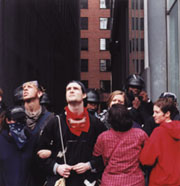|
By David Graeber
Hundreds of masked, black-clad anarchists adopted Gandhian tactics of nonviolent resistance during the IMF/World Bank protests in Washington, joining with other protesters in forming human chains blockading intersections, singing songs, playing musical instruments and greeting lines
 |
|
Although
the level of violence was far lower than in Seattle, brute force
was never more than a nightstick away.
Credit: Steve Anderson |
of heavily armed riot police with chants of "everything we do, we do because we love you." The news media, frustrated at the lack of images of violence and destruction, took vengeance in the only way they knew how: They declared the event a victory for the police.
The obvious contrast was with Seattle, where - amid the thousands of anarchists - a "Black Bloc" of about 70 or 80 militants carried out a systematic campaign of attacks against the property of particularly egregious multinational corporations. This was anything but random violence. In fact, the Black Bloc did not consider it violence at all, since they were careful to avoid doing anything that might physically harm people. (As one communiqué later put it: "We contend that property destruction is not a violent activity unless it destroys lives or causes pain in the process. By this definition, private property - especially corporate private property - is itself infinitely more violent than any action taken against it.") It did, however, provide an excuse for calling in the National Guard and for massive violence by soldiers and police.
In Washington, things were very different. The Black Bloc has become much larger; most anarchists seemed to be affiliated in one sense or another. But while more militant than most protesters (anarchists spent a lot of time piling up barricades and, in one instance, borrowing huge iron girders from a nearby construction site), this time a conscious decision had been made that there would be no attacks on property. This decision was adhered to with remarkable discipline, but it threw the mainstream press for a loop. After Seattle, they were clearly ready to paint anarchists as the left-wing equivalent of militia crazies, as a horde of rampaging Unabombers. Now what?
Anarchists disappeared from the coverage entirely; if they weren't rioting, then they weren't there (or weren't anarchists). Editorials also consistently treated protester self-discipline as a failure. A front-page editorial in the New York Times lauded Washington police for acting "sternly and pre-emptively" by forcibly shutting down the protest headquarters and rounding up hundreds of nonviolent marchers on trumped-up charges on April 15, which they said "allowed the police here to mostly avoid the kind of widespread chaos that disrupted world trade meetings in Seattle last year, a feat the protesters said they hoped to repeat." In other words: If the police manage not to run amok, but are calculating in their application of brutality in repressing constitutional rights, they win, and the newspapers will praise them; if the protesters fail to run amok, they lose.
TV reporters hammered the point home by consistently avoiding any pictures of the actual blockade - presumably on the principle that images of young people holding hands amidst music, colorful costumes, streamers and giant papier-mâché birds might leave too many young people in the audience with the impression that rebellion is fun - but instead endlessly focusing on those rare moments when police batons were descending on someone's head.
So far, the Black Bloc has refused to take the bait. Actually, the consensus among anarchists in the immediate wake of the demonstrations has been that their performance was a great success. Anarchists took the lead in a number of marches and actions, especially on April 17 during the rainstorm (one popular chant invented for the occasion: "We're wet! We're tired! Abolish the World Bank!"). The event proved an ideal forum for disseminating libertarian socialist ideas. In fact, the organization of the emerging protest movement as a whole has been along remarkably anarchistic lines - with no national leadership, no overarching hierarchies but a vast collection of autonomous affinity groups, each operating on principles of democratic consensus. If the movement continues to grow, and maintains its anti-authoritarian structure, the anarchist movement will continue to grow with it.
David Graeber is a professor of anthropology at Yale University.
|
In These Times ©
2000
Vol. 24, No. 13 |
